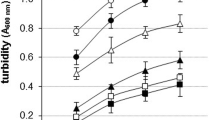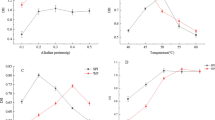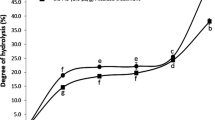Abstract
Argentina is a leading country in biodiesel production from soy. Extruded soy is a low-cost byproduct of the soybean oil industry, from which animal feeds are prepared as well as flour for human consumption. Soy proteins can be isolated from flours and digested with enzymes in order to obtain bioactive fractions. In this work, a commercial soy isolate (PRO-FAM 974) was characterized. Maximal solubility was achieved at a concentration of 90 mg/mL. Protein profiles obtained by SDS-PAGE showed that the isolate was constituted mostly by globulins. Conformational and thermal analyses (differential scanning calorimetry) showed that proteins were almost completely denatured. The isolate was hydrolyzed with a commercially available enzyme (COROLASE 7089). The peptide profile (MALDI-TOF) showed peptides ranging from 800 to 10,000 Daltons. We conclude that the product obtained has the potential to be used as functional ingredient for the development of functional foodstuffs, giving the opportunity to add value to the byproducts of the soybean oil industry.






Similar content being viewed by others
References
Ahmadifard N, Murueta JHC, Abedian-Kenari A (2016) Comparison the effect of three commercial enzymes for enzymatic hydrolysis of two substrates (rice bran protein concentrate and soy-been protein) with SDS-PAGE. J Food Sci Technol 53:1279. https://doi.org/10.1007/s13197-015-2087-6
Barac MB, Pesic MB, Stanojevic SP (2015) Comparative study of the functional properties of three legume seed isolates: adzuki, pea and soy vean. J Food Sci Technol 52:2779. https://doi.org/10.1007/s13197-014-1298-6
Blinkovsky AM, Khmelnitsky YL, Dordick JS (1994) Organosoluble enzyme-polymer complexes: a novel type of biocatalyst for nonaqueous media. Biotechnol Technol 8:33. https://doi.org/10.1007/BF00207630
Chen N, Zhao M, Chassenieux C, Nicolai T (2016) Data on the characterization of native soy globulin by SDS-Page, light scattering and titration. Data Brief 9:749–752. https://doi.org/10.1016/j.dib.2016.10.016
Chiang WD, Shih CJ, Chu YH (1999) Functional properties of soy protein hydrolysate produced from a continuous membrane reactor system. Food Chem 65:189–194
Cho SJ, Marcel AJ, Lee HC (2007) Cholesterol lowering mechanism of soybean protein hydrolysate. J Agric Food Chem 55(26):10599–10604
Coligan JE, Dunn BM, Ploegh HL (1995) Matrix-assisted laser desorption/ionization time-of-flight mass analysis of peptides. In: Speicher DW, Wingfield PT (eds) (Contributed by William J. Henzel and John T. Stults), current protocols in protein science, Volume 1. Wiley, New York, Unit 16.2
Doi HR (1991) Proteolytic activities in bacillus. Curr Opin Biotechnol 2:682–684
Etzel MR (2004) Manufacture and use of dairy protein fractions. J Nutrit 134(4):996S–1002S
Fitzgerald RJ, Meisel H (2003) Milk protein hydrolysates and bioactive peptides. In: Fox PF, McSweeney PLH (eds) Advanced dairy chemistry, Volume 1, 3rd Edition, Part B, pp 675–698. Kluwer/Plenum, New York/Dordrecht, pp 675–698
Ghumman A, Kaur A, Singh N (2016) Functionality and digestibility of albumins and globulins from lentil and horse gram and their effect on starch rheology. Food Hydrocoll. https://doi.org/10.1016/j.foodhyd.2016.07.013
Henry RJ, Cannon DC, Winkelma JW (1974) Clinical chemistry, principles and techniques, 2nd edn. Harper and Row, Hagerstown, pp 1354–1369
Horwitz W (2000) Official methods of analysis of AOAC International, vols 1 and 2, 17th edn. AOAC International, Gaithersburg
Kim SE, Kim HH, Kim JY, Kang YI, Wo HJ, Lee HJ (2000) Anticancer activity of hydrophobic peptides from soy proteins. BioFactors 12(1–4):151–155
Kitts DD, Weiler K (2003) Bioactive proteins and peptides from food sources. Applications of bioprocesses used in isolation and recovery. Curr Pharm Des 9(16):1309–1323
Kong XZ, Guo MM, Hua Y, Dong C, Zhang C (2008) Enzymatic preparation of 610 immunomodulating hydrolysates from soy proteins. Bioresour Technol 611(99):8873–8879
Korhonen H, Pihlanto A (2003) Bioactive peptides: new challenges and opportunities for the dairy andustry. Int Dairy J 16(2006):945–960. https://doi.org/10.1016/j.idairyj.2005.10.012
Kuo LC, Cheng WY, Wu RY, Huang CJ, Lee KT (2006) Hydrolysis of black soybean isoflavone glycoside by Bacillus subtilis natto. Appl Microbiol Biotechnol 73(2):314–320
Laemmli UK (1970) Cleave of structural proteins during the assembly of the head of bacteria pHage T4. Nature 227:680–685
Lee KH, Ryu HS, Rhee KC (2003) Protein Solubility Characteristics of Commercial Soy Protein Products. J Amer Oil Chem Soc 80:85. https://doi.org/10.1007/s11746-003-0656-6
Madureira AC, Pereira A, Gómes M, Pintado MalcataF (2007) Bovine whey proteins—overview on their main biological properties. Food Res Int 40:1197–1211
Nagpal R, Kumar A, Kumar M, Behare PV, Jain S, Yadav H (2012) Probiotics, their health benefits and applications for developing healthier foods: a review. FEMS Microbiol Lett 334:1–15. https://doi.org/10.1111/j.1574-6968.2012.02593.x
Paredes LO, Ordorica FC (1986) Production of safflower protein isolates: composition, yield and protein quality. J Sci Food Agric 37:1097–1103
Peñas E, Prestarno G, Baeza M, Martinez M, Gomez R (2006) Effect of combined high pressure and enzimatic treatments on the hidrolysis and inmunoreactivity of dairy whey prot. Int Dairy J 16:831–839
Petruccelli S, Añon MC (1995) Thermal aggregation of soy protein isolates. J Agric Food Chem 43:3035–3041
Pihlanto A (2001) Bioactive peptides derived from bovine whey proteins: opioid and ACE-inhibitorypeptides. Trends Food Sci Technol 11:347–536
Sanz Pérez B (2005) El variado mundo de los alimentos funcionales nutracéuticos y suplementos dietéticos. Cascales Angosto M, Espinos Pérez D, García Barreno P (eds) En Bioquímica y fisiopatología de la nutrición. Instituto de España. Madrid, pp 133–208
Secretaria de Agricultura, Ganadería, Pesca y alimentación (2016). www.sagpya.mecon.gob.ar
Shevkani K, Singh N, Kaur A, Rana JC (2014) Structural and functional characterization of kidney bean and field pea protein isolates: a comparative study. Food Hydrocoll 43(2015):679–689. https://doi.org/10.1016/j.foodhyd.2014.07.024
Singh BP, Vij S, Hati S (2014) Functional significance of bioactive peptides derived from soybean. Peptides. https://doi.org/10.1016/j.peptides.2014.01.022
Smith KE, Bradley RL (1987) Activity of four anzyme-based cleaners for ultrafiltrations systems against proteins in skim milk and whey. J Dairy Sac 70:243
Takahiro T, Katsuki K, Masakazu T, Makoto T, Taiji M, Masaaki Y (2003) Soymetide, an immunostimulating peptide derived from soybean β-conglycinin, is an fMLP agonist. FEBS Lett 540(1–3):206–210
Takahiro T, Kyoya T, Masaaki Y (2005) Anti-alopecia mechanisms of soymetide-4, an immunostimulating peptide derived from soy β-conglycinin. Peptides 26(5):707–711. https://doi.org/10.1016/j.peptides.2005.01.010
Vinderola CG, de Moreno de LeBlanc A, Perdigón G, Matar C (2008) Biologically active peptides released in fermented milk: role and functions. In: Farnworth ER (ed) Handbook of fermented functional foods 2nd edition, Chapter 7. CRC Press, Taylor & Francis Group, Boca Raton, pp 209–242. ISBN: 9781420053265
Vioque J, Clemente A, Pedroche J, Yust MM, Millán F (2001) Obtention and uses of protein hydrolysates. Grasas y Aceites, ISSN 1988-4214. http://dx.doi.org/10.3989/gya.2001.v52.i2.385
Acknowledgements
The authors thank Dr. María Cristina Añón, Centro de Investigación y Desarrollo en Criotecnología de Alimentos (CIDCA, UNLP-CONICET) for collaborating with the thermal and conformational studies of the protein isolate, Dr. Silvia Moreno, Centro de Estudios Químicos y Biológicos por Espectrometría de Masa (CEQUIBIEM) for collaborating with the mass spectrometry studies. Dr. Sandra Elizabeth Perez and Daniel Starck, Centro de Investigación Veterinaria de Tandil (CIVETAN) for collaborating with the language review.
Author information
Authors and Affiliations
Corresponding author
Ethics declarations
Conflict of interest
The authors declare no conflict of interest in this work.
Additional information
Publisher's Note
Springer Nature remains neutral with regard to jurisdictional claims in published maps and institutional affiliations.
Rights and permissions
About this article
Cite this article
Conti, J.P., Vinderola, G. & Esteban, E.N. Characterization of a soy protein hydrolyzate for the development of a functional ingredient. J Food Sci Technol 56, 896–904 (2019). https://doi.org/10.1007/s13197-018-3551-x
Revised:
Accepted:
Published:
Issue Date:
DOI: https://doi.org/10.1007/s13197-018-3551-x




